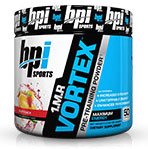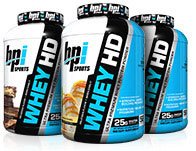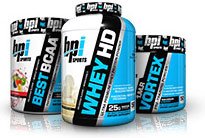
Get Defined: 26 Must-Know Fitness Terms
Just getting started on your fitness journey, or want to test your knowledge of important terms? Check out this A-Z guide to some of the most common concepts in fitness!
The only thing more daunting than starting or resuming a workout program every January is the vocabulary of terms that seasoned lifters throw around, as if speaking in a foreign tongue. Fear not! We've got quick and easy explanations of 26 common fitness terms and concepts, arranged from A to Z.
Peruse the list so you can learn to walk the walk and talk the talk.
Anaerobic vs. Aerobic
Quite simply, anaerobic means without oxygen and aerobic means with oxygen. An anaerobic exercise is done nearly all-out, and therefore can't be done for a long period of time. Think of a 100-meter sprinter. The fuel his muscle cells use is supplied for quick bursts of energy only and doesn't require the presence of oxygen, but can't be sustained for long periods.
On the other hand, a lower-intensity activity such as moderate bicycle riding uses a different energy pathway that can be done for an extended period of time. This process does require oxygen.

Besides being able to sustain the activity for a longer period, the metabolic process also burns circulating triglycerides (fat) from the bloodstream and stored body fat more readily.
Bodybuilding movements are typically anaerobic, whereas endurance activities are aerobic in nature.
Branched-Chain Amino Acids
These three essential amino acids—leucine, isoleucine, and valine—have a unique branched-chain structure. During exercise they are broken down and preferentially taken up by skeletal muscle.
Ingestion of BCAAs (5-10 g daily) can stimulate anabolism, while research also shows these three amino acids have anticatabolic properties, reduce exercise-induced muscle soreness, and decrease mental fatigue during intense exercise.1,2
Concentric
When you lift a weight against gravity, a muscle contraction (shortening) takes places around a joint or joints. For example, when you do a biceps curl, the biceps muscle—which is connected to the elbow and shoulder joints—contracts to lift the weight. This action is called a concentric, or positive, contraction.

As you lower the weight, the biceps is being stretched or lengthened, which is known as the eccentric (or negative) contraction. It's important to note that strength isn't measured only by how much you can lift (the concentric motion), but also controlling the eccentric.
Dropsets
Most bodybuilding-training programs require you to lift a weight to positive rep failure—until you can't do any more reps on your own with good form. But just because you can't do another rep with the weight you're using doesn't mean you have to end your set. Quickly reducing the weight allows you to extend a set past muscle failure.
Dropsets are an advanced training technique that is superior for burning additional calories and inducing a deep muscle burn. When you reach a point of momentary muscle failure, reduce the working weight by 20-30 percent and immediately resume the set, training to a second point of muscle failure.
Exercise Database
Where's the best encyclopedia of exercise information on the web? Click on Bodybuilding.com's Exercise Database for the most comprehensive and authoritative guide to just about any and every movement you can do!
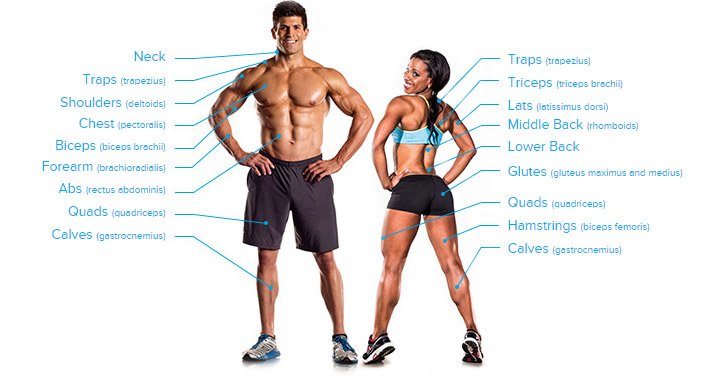
Whether you're into powerlifting, bodybuilding, plyometrics, calisthenics, or even stretching, we've got an exhaustive list of hundreds of movements, with pointers, photos, and videos so you can follow along.
Use the filters to sort by body part, type of equipment, experience level, and highest-ranked exercises (as rated by our members), or just browse through the hundreds of movements to find new ways to add variety to your workout. Get the best tips—no personal trainer required.
Failure
Training for muscle size is optimized when the lifter takes a set to the point of muscle failure; that is, he or she is unable to complete another repetition with good form. Typically a set ends as fatigue sets in and the lifter is unable to overcome what's called a "sticking point."
Training to the point of muscle failure on most sets creates favorable intracellular conditions for muscle growth, given good nutrition and rest. Too many sets to failure (or past failure using advanced training techniques) can result in overtraining, while too few sets can result in suboptimal muscle growth.
Beginners, however, should be less concerned with achieving muscle failure when learning correct movement patterns, so that good technique will result in muscle growth, not an injury.
Glycemic Index
This is a measure of how fast carbohydrate foods enter the bloodstream after eating, ranked on a scale of 0-100. Some sugars, like glucose, don't have to be broken down in the digestive system and enter very quickly, while others—especially long chains of complex-carbohydrate foods—take much longer to enter the bloodstream.
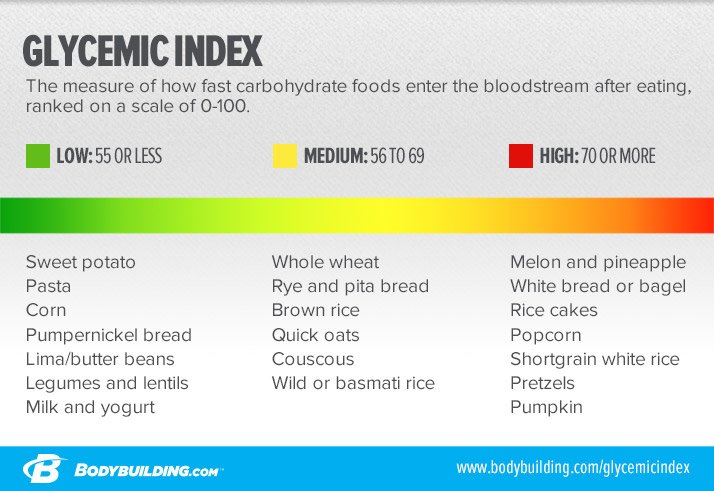
Higher glycemic foods elevate insulin levels quickly, which encourages the storage of nutrients in both muscle and fat cells. If insulin is spiked too frequently it can leads to storage in fat cells.. Lower glycemic foods produce gradual rises in blood sugar and insulin, which in turn may help control obesity, diabetes, coronary heart disease, and appetite.
It's important to note that most foods are a combination of different macronutrients, so the glycemic index of a carb food alone isn't a perfectly accurate picture of digestion.
Hypertrophy
A word that simply refers to muscle building by the process of enlarging individual muscle fibers. Muscle fibers grow through protein synthesis, in which fibers damaged by resistance training rebuild themselves (adapt) by becoming stronger and larger in response to the training stimulus.
Skeletal muscle is best trained for hypertrophy by choosing a weight in which you can do 8-12 reps per set to muscle failure with good form for 3-5 sets.
Intensity
Most of us think of intensity in terms of how hard we work, but that's not how exercise scientists define it. For these guys, it relates to the percentage of your maximal lift (often called a percent of your 1RM, or one-rep max). For instance, if you can bench press a max of 275 pounds, and you do a set of 225 pounds, that equates to just above 80 percent of your 1RM.
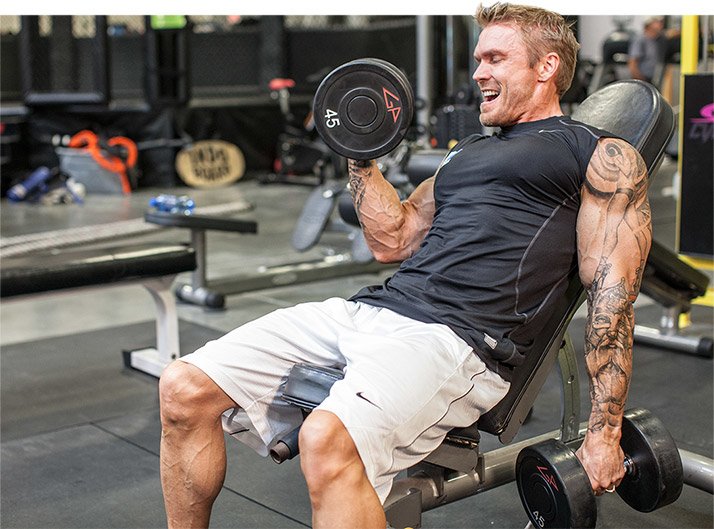
Workouts are sometimes written with instructions to train at a certain percentage of your 1RM, which is described as a particular training intensity. Higher-intensity workouts have a lower RM. For example, a heavy weight that corresponds to your 4RM— a weight that you can lift for only 4 reps—is about 90 percent of your 1RM.
Joints
Muscles contract around a single joint or multiple joints to create action, whether you're running down a field or doing a push-up. The skeletal muscles have attachments at the joint (called points of origin and insertion) or along bones.
In resistance training, some exercises require just a single set of joints—think of the leg extension and the pivot point at the knees. These are called single-joint exercises. Others movements utilize multiple joints—in the aforementioned push-up, for example, action takes place namely at the shoulder and elbow joints. These are called multijoint or compound movements.
Multijoint exercises recruit a greater number of muscles, and are thus generally more difficult to perform, but allow you to use more overall weight than single-joint exercises. Whether you're goal is to build muscle or lose weight, multijoint movements should form the foundation of your training.
Kettlebells
A kettlebell is a round weight with a handle, distinct from traditional dumbbells, that was originally developed centuries ago in Russia as a means for weighing crops. Unlike dumbbells, which distribute weight evenly over the hand, the kettlebell's center of gravity extends beyond the hand, which better allows for swinging or ballistic movements.
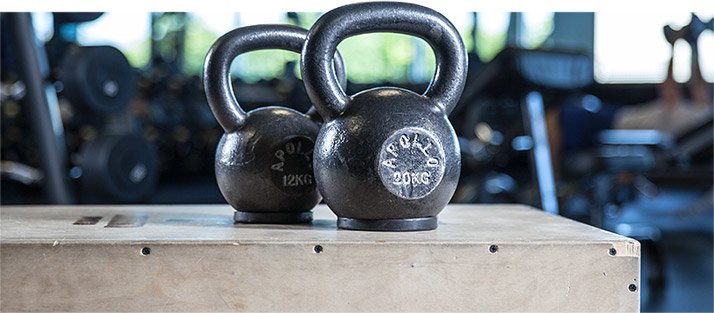
Because the unique shape is inherently unstable, it allows for greater strengthening of grip, wrist, arm, and core. Today, there are complete kettlebell workouts that offer distinct cardiovascular, strength, and flexibility advantages over dumbbells.
Load
Another name for weight or amount of resistance. A load can be associated with a percentage of your max, which is different for everyone. If your max bench press is 275 pounds, that load is associated with your one-rep max (1RM). You can compute loads of 60 percent, 70 percent, or any other percentage of your 1RM simply by multiplying your max weight (here 275 pounds) by the percentage.
For building muscle, utilizing loads between 65 and 80 percent of your 1RM is advantageous. This correlates to 8-12 reps. If your goal is strength, heavier loads are best—typically 85 percent or more of your 1RM. Of course, warm-up sets are necessary before doing heavier loads.
Metabolism
The process by which your body converts what you eat and drink into energy. Complex biochemical processes utilize oxygen in the conversion of nutrients, releasing energy that can be stored or released during work or normal bodily functions.
The number of calories your body requires to undertake its most basic functions—including digestion, breathing, circulation, repairing cells, releasing hormones, even sleeping—is called basal metabolism. Your individual metabolism is determined by many factors, including your weight and body composition, your sex, and your age.
Calorie Calculator
* Mifflin-St. Jeor Equation
Obviously, physical activity determines how many calories you burn a day, and more muscle tissue increases your overall metabolism, even at rest. Metabolism can affect weight gain, but that's most likely due to too many calories consumed or too little physical activity.
Nutrients
You are what you eat, and everything you eat contains either protein, carbohydrates (including fiber) and/or dietary fats. These foods are broken down into their smallest components during digestion before being absorbed by your body and entering your bloodstream to be put to use. A gram of protein and a gram of carbs each has 4 calories, while a gram of dietary fat has 9.
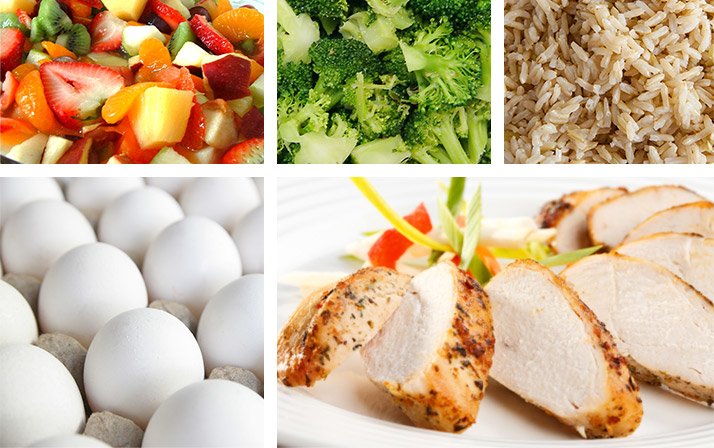
But each macronutrient has different functions, and all of them must be consumed for optimal function and health. Your body also requires smaller amounts of micronutrients—vitamins and minerals that are essential for a range of functions. Deficiency in key micronutrients can affect performance or health.
Overtraining
This is a state in which your body's recovery ability can't keep up with the volume and intensity of your training program. It manifests itself in physical and emotional states where progress stalls, but losses may also occur in strength and fitness because of increased catabolism.
Signs of overtraining include fatigue, elevated resting heart rate, insomnia, persistent muscle soreness, weight loss, increased incidence of injuries and susceptibility to illness, poor exercise performance, low testosterone levels, and possibly depression.
To combat overtraining, dialing back your training is essential (either by taking a break or reducing the volume and intensity), as is getting more sleep and keeping a better eye on your diet.
Periodization
Periodization is the systematic planning of your training. While inexperienced lifters may think training full-bore every workout is the way to go, science shows that the best way to make size and strength gains long-term is to cycle periods of volume and intensity.
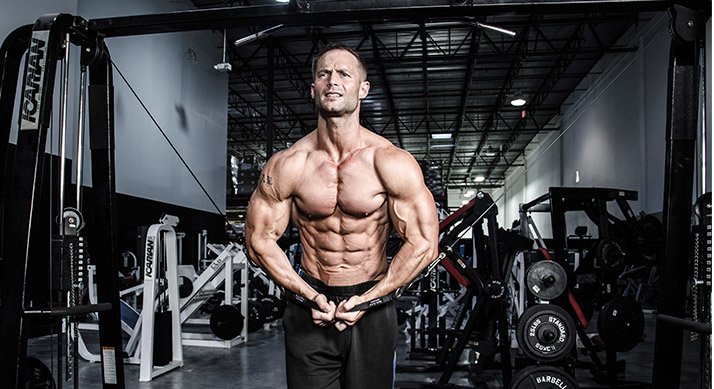
Begin with a short-term period of low intensity (weight), then ramp up the volume and intensity over time, culminating in a short period of very high-intensity work, and start all over again. This not only allows for peak performance (timed with a competition date), but allows you to begin the next cycle with a stronger base.
Quadriceps
The group of four muscles on the front of the thigh that work to extend the knee and hip is called the quadriceps. These four muscles work in tandem; though particular areas can be emphasized, none can be isolated completely. The antagonist muscles to the quads are the hamstrings (three muscles on the back of the thigh). When the quads are flexed, the hamstrings are being stretched, and vice versa.
This balance supports the integrity and stability of the knee joint. Thus, when one side is trained and the other is not, an imbalance may occur over time and put the joint (and musculature) at greater risk of injury.
Recovery
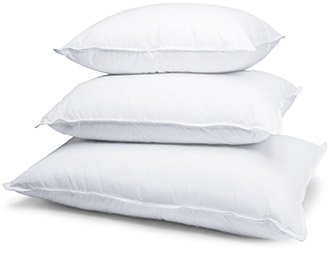
Hard training is essential for muscle growth, so you may think even more training is better. But that's not how it works. Your workout is the stimulus to begin a process of muscle breakdown and regeneration, an adaptation response that allows muscle to become bigger and stronger. But that recovery process takes place outside the gym and requires considerable nutritional support (including all the macronutrients and micronutrients) and rest. Short change any one of those recovery factors, and your growth potential is limited.
Many lifters subscribe to a theory of getting into the gym and training hard for a short period of time, then getting out and focusing on good nutrition and recovery to maximize growth. In that sense, fitness is truly a 24/7 endeavor.
Supplements
Supplements augment your training and nutrition. Hard training burns calories, and if you're looking to build muscle, you need to not only replace the calories that were expended during your workout, you need to consume enough to support muscle repair and growth. For most individuals, consuming that much whole food is difficult given today's demands from work, school, and social life.
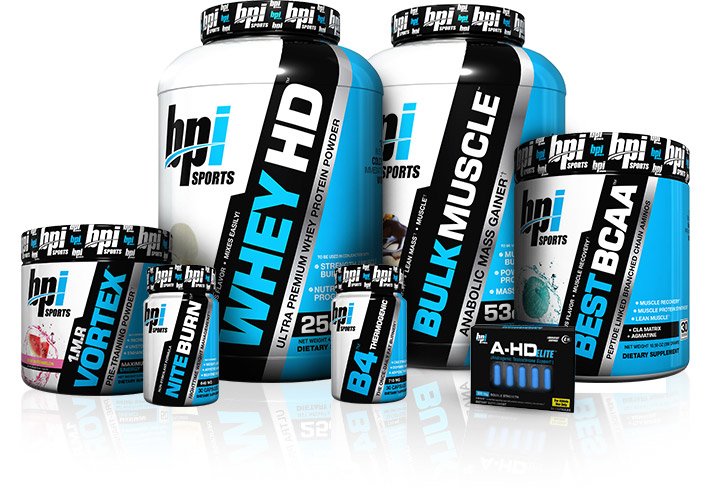
Supplements are especially helpful because they enable lifters to consume more calories (especially protein) in a convenient manner when whole-food choices aren't readily available.
In addition, specific supplements can better help you reach your goals, whether you want to gain mass, lose fat, increase endurance, improve performance, or improve health.
Tempo
This refers to the speed of a movement. Generally speaking, when training to build muscle, you use an explosive motion to lift the weight, hold the peak contraction momentarily, lower it more slowly under control during the negative (eccentric) contraction, then smoothly reverse direction at the bottom of the range of motion without bouncing.
Different training protocols can shorten or lengthen any one of those parts of the rep to achieve particular results. In addition, different training programs like plyometrics, in which you move explosively without deceleration, are variations of tempo.
Unilateral
Training just one side of your body at a time is called unilateral training. In barbell and some machine training, you lift a weight with both arms or both legs—each side of your body making equal contributions—which allows you to use a tremendous amount of weight.
Because of an injury, muscular imbalance, or particular goal, you may consider training each side independently, which can more readily be done with dumbbells or some machines that allow each side to work separately.
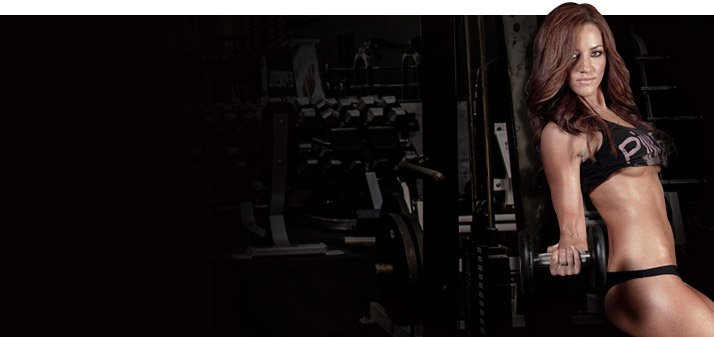
Unilateral training typically allows you to achieve a slightly longer range of motion and greater intensity. When done with dumbbells, unilateral training requires greater stabilizer activity, as the weight is more difficult to control.
There are advantages to each type, so including both bilateral and unilateral training in your workouts can maximize your results.
Vitamins
Vitamins are organic chemical compounds that are necessary for biological functions, including growth and development. The chemicals are grouped under alphabetized letters, such as vitamin A or D. The B-complex vitamins aid enzymes as catalysts of metabolic functions, especially energy production. Vitamins A, D, E, and K are fat-soluble vitamins that are transported throughout the body via fat, and are important in hormone production.
Vitamin D in particular can also be synthesized in the skin with sunlight. Some methods of food preparation and cooking can cause vegetables, meat, or fish to lose some of their vitamin content.
Whey Protein
Whey protein is considered the gold standard of bodybuilding supplements, but what is it? Whey is derived from the cheese making process. It's a complete protein that's high in the essential amino acids and BCAAs, and it has been shown to elevate protein synthesis after resistance training.
Various methods can be used to selectively filter and process whey protein to make it digest faster, including whey protein isolate and whey protein hydrolysate. Both of these have been shown to be associated with higher rates of muscle-protein synthesis.
XXL
Getting big, as in extra-extra-large! Gaining muscle size requires a combination of hard training, recovery, and consuming more calories than you expend. All three areas must be accounted for in the pursuit of lean muscle tissue.
In the gym, adding mass includes a number of components: using a high volume (exercises, sets, reps) of work for a given muscle, stressing it with moderate loads (using a weight that you can just complete for 8-12 reps) from multijoint movements, and repeating that body part every 3-6 days (the more volume and intensity you use, the longer the recovery).
Your BodySpace Account
What's the world's number one online fitness network? If you guessed Facebook, you're way off. BodySpace allows you to share your progress pics and goals, track your workouts, make fit friends, and help you stay accountable to your workouts.

With tons of tools that are geared for serious and novice lifters alike, you can even access it on your phone! Now it's easy to stay motivated!
ZZZs
If you've paid attention to what we've said about recovery, you know that getting enough sleep is just as important to the muscle-growth equation as training and good nutrition. It's during deep sleep that your body releases muscle-building growth hormones and testosterone, substances that act as "on" switches for anabolism.
Short-change your bedtime and you risk slowing growth or hampering your recuperative abilities. Because you're fasting a good 8-10 hours during the night, slow-digesting protein like casein is an ideal pre-bedtime snack to supply amino acids all night long.
References
- Blomstrand, E., Hassmen, P., Ek, S., Ekblom, B. & Hewsholme, E.A. (1997). Influence of ingesting a solution of branched-chain amino acids on perceived exertion during exercise. Acta Physiologica Scandinavica, 159(1), 41-49.
- Matsumoto, K., Koba, T., Hamada, K. Sakurai, M., Higuchit, T. & Miyata, H. (2009). Branched-chain amino acid supplementation attenuates muscle soreness, muscle damage and inflammation during an intensive training program. Journal of Sports Medicine and Physical Fitness, 49(4), 424-431


